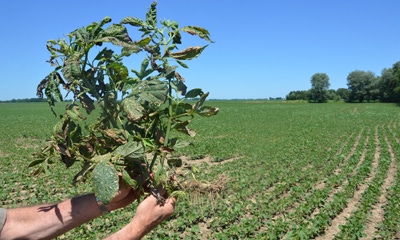
Even if you were generally satisfied with weed control this year, odds are you had at least a few escapes. What causes a giant ragweed in a soybean field, like the one pictured below, to somehow escape an accurate herbicide application with effective herbicides?
Bill Johnson, Purdue University Extension weed control specialist, says there is no one reason. There are actually several possibilities, plus it could be a combination of one or more factors. He also says it’s worth exploring which factor or factors may have contributed to allowing this weed to escape. If you hit on possible causes, you can make adjustments for next season.

DOWN BUT NOT DEAD: This weed was injured by the herbicide application, but not killed. Read on to find five reasons why it may have survived.
Here are Johnson’s top five questions to consider to determine reasons why this weed may not have died, but instead regrew.
1. What size was the weed when it was sprayed?
“Perhaps it was too big for the herbicide when the herbicide was applied,” Johnson says. “Weed size is a big deal. You need to check herbicide labels carefully.”
In this case, since conventional tillage was used to prepare the seedbed, it’s also possible that this weed wasn’t killed by tillage, just injured. The way it sent roots into the soil along the stem lying on the ground might be an indicator.
2. What rate of herbicide was applied?
Herbicide rates are crucial, especially on larger weeds or weeds that the herbicide does not control as easily in the first place, Johnson explains. In fields where several weeds escaped control, it might be worth double-checking to see what rate you applied. Trying to skimp on rate can be costly, especially if the herbicide isn’t as strong on some of the weeds in your field as you might like.
3. How much coverage did you get of the target weeds?
Sometimes the person spraying may only apply 10 gallons of solution per acre when the label recommends 20 gallons per acre, just to carry less liquid and save time. There is likely a reason why the label says 20 gallons should be applied per acre, if it says that, Johnson says. The total volume applied per acre can be a factor in determining degree of coverage on target weeds.
4. Are you starting to see resistance to the herbicide?
You can’t tell if a weed is resistant just by looking at it, Johnson notes. However, with weeds where known resistance exists, such as giant ragweed, it’s possible some plants didn’t die because they can survive a rate of herbicide that once killed all weeds of that kind. If weed resistance is developing, it may require a different weed control strategy in the future.
5. Were weather conditions challenging when the herbicide was applied?
The primary question here is if weeds were actively growing at the time of application, Johnson says. When weeds are stressed by drought or other environmental conditions and aren’t actively growing, they become tougher to kill.
About the Author(s)
You May Also Like




